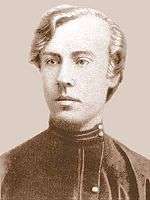Stepan Balmashov
Stepan Valerianovich Balmashov, (Russian: Степан Валерианович Балмашев) (April 15, 1882 - May 16, 1902) was the Russian student who assassinated the Minister of Internal Affairs Dmitry Sipyagin in April 1902 in the Mariinsky Palace in St. Petersburg. He was hanged in the fortress of Schlisselburg in May 1902, aged 21.

University life
Balmashov was born in Archangelsk, into a political family. His parents were Narodniks who had been sent into administrative exile in Archangel. In 1900, he entered the Taras Shevchenko National University of Kiev and immediately got involved in the student movement, which was undergoing a revival. The government's response to student unrest was to issue a decree ordering 183 students to surrender to the army. In January 1901, Balmashov was arrested, as one of the leaders of the disturbances, and spent three months in prison. After his release, he was confined to Roslavl, in Smolensk province, under military supervision. In Autumn 1901, a change in government policy enabled him to free himself from military supervision, and move to Kharkiv, where he was counting on being allowed into the university, but was barred because of his 'unreliability'. During a month in Kharkiv, he made contact with revolutionaries, and became actively involved in both Marxist and populist circle, explaining that he did not see any significant differences between Social Democrats and the Narodniks. Returning to Kiev, despite his past record, he was readmitted to university, but there was another outbreak of student disturbances, followed by a crackdown and a mass deportation of students to Siberia, for which Balmashov blamed the Minister, Sipyagin.[1]
Assassination of Sipyagin

In 1902, several narodnik groups merged to form the Socialist Revolutionary Party, which included a Battle Organisation headed by Grigory Gershuni, charged with assassinating government officials. Gershuni decided that Sipyagin would be their first target. Balmashov volunteered to be the assassin.[2] On April 15, 1902 (April 2 Old Style), Balmashov arrived disguised as an employee to the Mariinsky Palace, where the Minister of Internal Affairs was supposed to be. However, the minister had not yet arrived. He returned somewhat later and told the doorman that he had some documents from the Grand Duke Sergei Alexandrovich. When Dmitry Sipygan arrived, he then positioned himself behind the minister and shot him several times, leaving him with serious injuries that resulted in his death an hour later.[3]
Investigation, trial, and execution
During his questioning, Balmashov stated that, "the method of combating a terrorist seems to me inhumane and cruel, but it's inevitable with the current regime", and refused to say anything else. A military tribunal sentenced him to death by hanging. Even though various people recommended that he request a pardon, none was given. The execution took place in the fortress of Shlisselburg in May 1902.
References
- Shmidt, O.Yu. (chief editor), Bukharin, N.I. et al (eds) (1926). Большая советская энциклопедиа Volume 4. Moscow. pp. 543–4.CS1 maint: extra text: authors list (link)
- Nicolaevsky, Boris (1934). Aseff: the Russian Judas. Hurst & Blackett: London. p. 56.
- Peter Kropotkin (1905-01-01). "The Constitutional Movement in Russia". revoltlib.com. The Nineteenth Century.